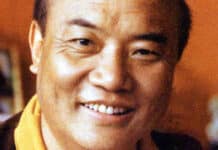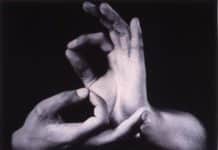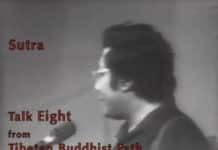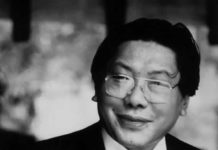Since video recordings are available for only four of the seven talks, we have included the audio recordings for the entire seminar below.
Tail of the Tiger, July 1973.
Notes from Robert Walker
Talk One: An Introduction to Lineage and Devotion
(The sound quality of the audio of excellent; the talk portion is about 15 minutes, with about 20+ minutes of questions and answers)
This first talk of the message of the Milarepa seminar, July 17, 1973, introduces Milarepa as a lineage holder of the Kagyupa lineage, a “lineage which belongs to the devotional tradition.” Devotion, here, is connected to developing “a basic understanding of the nature of ego,” and, having realized that, developing renunciation. In the Kagyu Buddhist teachings, a basic understanding of the complete Buddhist path is emphasized, working with all the subtleties of life, not vajrayana alone.
The hagiographies of lineage holders are stories of people encountering their own neurosis, pain, and dissatisfaction with ego. The first message is that neurosis, synonymous, here, with pain, is not thrown away: “We do not dwell on that, but we try to work with it.”
Trungpa Rinpoche gives a thumbnail sketch of Naropa’s path, as one who searched for an enlightened teacher, having mastered the conventional hinayana and mahayana teachings of the day. The different personalities, paths, of other lineage teachers (Tilopa, Marpa) are also sketched out a bit, the point being that these different teachers themselves were quite different from each other. There is no one “type” of student or style of enlightenment.
One thing that is consistent in the paths of all lineage holders of this tradition is the importance of devotion and relationship between teacher and student. This relationship is characterized differently in the hinayana, mahayana, and vajrayana teachings: trust and respect of the hinayana elder, the mahayana spiritual friend, and the vajrayana master warrior.
The questions and answers get further into questions of devotion, lineage, crazy wisdom, working with resentment, and a few other topics.
Talk 2: First part of Milarepa’s life: the trap of one-upmanship
(Message of Milarepa, Talk 2, 7/17/73, Tail of the Tiger)
In this second talk of the Message of Milarepa seminar, Trungpa Rinpoche discusses the first part of Milarepa’s life, the family chaos, aggression, and his own retaliation, murdering many family members. It is “the confused and wretched ego manifesting itself” which “destroys Milarepa’s life.” The second part of his life, “trying to thin out the confusion, chaos, and neurosis” and the third part, when “the whole thing opens into the mahamudra state of mind…” are discussed in subsequent talks.
A main theme of this talk is that our family situations, response to authority, and our response to relationships altogether are not so different from what Milarepa and his family members went through. “We might laugh at games that went on in 14th century … Tibet, but we might be doing the same thing right now. It is not our family situation(s) alone, but friends, lover level — we do some replica of those things, not new to us, those evil games happen all the time.”
This is an important theme of Trungpa Rinpoche’s teachings on relationships. For example, in the Work, Sex, and Money seminars (also on Chronicles), he spoke of the tendency for parents and spouses to treat their children or mates like property, rather than cherished human beings or friends. All of this is in the name of security, building a false sense of identity, or a false sense of power in the midst of weakness — whether that identity is based on an inflated sense of heroism or just trying to be a reasonable, moderate, safe person. “That playing one-upmanship is not entirely new to us, whether we try to become powerful by magic or not … Everybody [is] playing that hand, particularly in relationships; trying to play upper hand is [a] natural thing. The more threat, the more we try to be up and press down [the other], destroy and sit on it.”
So, we could identify with the situations of Milarepa and his family members as relating to our own path. We also may feel oppressed based on being poorly treated, or feeling that we were treated poorly, or feeling that we were not encouraged enough, or were encouraged in a way we did not like, or in a way which did not correspond to our ambitions, or felt that our talents and powers were actually suppressed. As elders or people in power, we may feel threatened by a “paranoid young(er) generation [that] might revolt … applying intellectual, scientific, and economic logics.” Based on such, we may suppress our children in various ways, or even attempt to crush them, and as parents or children, we might also harbor revenge fantasies, or actually take revenge.
At this point in the seminar, Trungpa Rinpoche’s teaching seems to be inviting us to simply acknowledge these inter-generational ego games of one-upmanship — and the pain, suffering, and chaos that ensue, for what they are: a vicious whirlpool of suffering, a claustrophobic trap where one may feel utterly cornered.
In Milarepa’s case, after his father’s death, his uncle held most of the wealth, and basically enslaved Milarepa’s family, employing his mother as a maid. Trungpa Rinpoche describes the traditional iconography of Milarepa being used as a milking stool, and as a stool for his uncle to mount his horse. Milarepa was seen as “a tremendous threat to his uncle; if he became strong, he could revolt.” His uncle “put … pressure on his mother and himself, constantly” so that he could “be subdued into (an) ordinary, submitting child … The plan of [the] uncle and aunt was to destroy him completely so there would be no hope of claiming [his late father’s] property … total destruction so that [the] spirit of [the] Mila family could be destroyed, [and] so [that the] uncle’s family could enjoy further wealth.”
“The claustrophobia of Milarepa’s early childhood is enormous, extremely sad and penetrating.”
In the playing out of the revenge Milarepa mastering black magic to bring down the roof on a wedding celebration, killing dozens of family members — Milarepa’s relationship with his mother was very important. Generally speaking, in mythology and in real life, male heroes of all kinds, positive and negative, are tremendously inspired by their mothers. That’s one of the basic male fantasies: doing good by their mothers and, in the process, fulfilling their own heroic vision of themselves. Milarepa’s mother inspired him, rather than running away to become a bandit (a reasonable career choice), to master the family situation, bringing the “Mila” name back to honor and power, through appropriate revenge. “[The] mother is like the arrow, and [the] son is like spearhead tip of arrow. [The] son could prove [the] mother’s existence as [a] strong Mila-family person.”
In our modern-day world, dominated by blood feuds and economic, political, and social atrocities of all kinds and our skill as human beings to use and manipulate each other in various ways — few stories do justice to the psychological, interpersonal, and political dynamics as well as the real-life experience of Milarepa’s early years.
Talk 3: Revulsion with Samsara
(Message of Milarepa, Talk 3, 7/18/73, Tail of the Tiger)
(Talk portion about 25 minutes, questions and answers another 30 minutes)
This third talk of the Message of Milarepa seminar could be entitled “Revulsion with Samsara.” (Later in the 1970s, Trungpa Rinpoche changed the translation of the Tibetan word Zhen-lok, as found in the Kagyu lineage supplication, from “renunciation” to “revulsion,” as in “Revulsion is the foot of meditation.” Such revulsion, nausea with samsara, could lead to renunciation, turning away from samsara, the inspiration to “step out and breathe fresh air.” Those two movements: from nausea to stepping out, seem to be the basic logic of this talk.) The following quotes from this talk are approximate:
“The Tibetan word for renunciation is zhen-lok…, which means, literally, state of being … nausea, feel[ing] sick that you had same thing all over again and to the point of being sick … Zhen-lok in this case is [the] result of exercising too many freedoms to ourselves, our ego has too much freedom … That we be spinning around in samsaric whirlpool and finally getting dizzy and helpless. And if we go too far, if we repeat it too many times, that the possibilities of completely losing track…of sanity to the point of breakdown. So the renunciation is, you have a personal experience: The experience of life is fruitless, one game after another game …, and it does not fulfill the fundamental purposes at all…
The point of renunciation at the beginning is somewhat the sense of rediscovering our own unpleasantness, particularly when we try to launch into any particular project trying to save ourselves from that embarrassment to ourselves, or discomfort to ourselves. That makes us nauseous; nauseating. That we are: “Here we go again,” and “I’m just about to throw up. I can’t get onto that track again and again.” There is a sense of more than boredom with ourselves: that we realize our repetition as something terribly claustrophobic and sickening in many ways … That there is a sense of claustrophobia; you want to step out, breathe fresh air, just to change the subject. So at the beginning there is a sense of imprisonment, which inspires the sense of renunciation at the beginning. And that was the state of mind of Milarepa at the time.”
The short-term success of Milarepa’s plan trapped him as a murderer and outcaste, a practitioner of black magic without social standing and with poor long-term prospects. There was no more future in black magic, from any point of view. So, then what? Turning to his students, Trungpa Rinpoche compared this to the relative success of our own samsaric games, our small or large ambitions related to figuring out how to survive in the world, how to be somebody. Such “criminality” — criminal from the point of view of the enlightened mind — may be too subtle to be picked up by the legal system. “Only [the] karmic situation picks up such subtlety.” Like Milarepa, we also could feel trapped, to the point of nausea, in whatever lifestyles we have fought so hard to achieve. So, then what?
Based on zhen-lok, revulsion, one could be inspired to look for a teacher, as Milarepa did, and as many of us have. There is a search for the dharma, as in the case of Milarepa, “largely trying out which one works best.” Phase two, then, would be becoming a spiritual shopper, a dilettante. “When we feel let down by our own ambition, embarrassed by our criminality, we try to find a way to a more spiritual approach, and our shopping trip begins to happen at that point.”
Interestingly, Trungpa Rinpoche presents such spiritual shopping as an obvious and perhaps necessary step, the first impulse towards renunciation, a mixture of egoism and buddha nature. It’s important to shop, to look into what’s best … which brings us to Milarepa’s own journey towards discovering and entering into relationship with his teacher, Marpa, at which point “some other message comes through.” That would be addressed in the next talk.
Trungpa Rinpoche ends talk 3, after the questions and answers, by strongly encouraging students to attend the all-day sitting session, the nyinthun, the following day. This encouragement of intensive sitting practice is something that he did many times, over and over, in the course of his teachings, not just in the early days, but through the 1980s as well.”I hope everybody will be able to take part in this. It’s extremely important. In order to relate to Milarepa’s life, imitate Milarepa’s style, just for one day, which is very encouraging not only to yourselves but to America. We could be American Milarepa’s, not Japanese or Tibetan; you could be American Milarepa. You could be brave and trusting yourself.”
Talk 4: Shopping for a teacher. Relationship with Marpa: cutting through spiritual and psychological materialism.
(Message of Milarepa, Talk 4, 7/19/73, Tail of the Tiger)
In this talk, Trungpa Rinpoche discusses Milarepa’s initial spiritual shopping for a teacher — the extraordinary promises, the fascination — and his inability, initially, to discover ” a real person who could communicate with him.” The talk also describes how Marpa became that real person for Milarepa. We could share that problem in our own spiritual search — the tendency to be fascinated, haunted by our own fascination, and ultimately our inability to relate with teachers and teachings. We also could philosophize and romanticize our shifting view of the teacher, and therefore of ourselves, the versions of ego that we keep developing and protecting.
Relationship with a genuine teacher cannot be bought with money alone, or seeming helplessness alone, or by being a good boy or girl, or by flattering the teacher with some ideal image of who he or she is supposed to be. Before meeting with Marpa, Milarepa met with other teachers and went through cycles of expectation, fascination, and disconnection.
When Milarepa met Marpa, he did not know the man was Marpa, at first. There was just this farmer who demanded work for information. Trungpa Rinpoche characterized this first encounter as a “casual” one, “human and accurate,” not playing on Milarepa’s weakness — which was his fascination, his extreme state of expectation. Trungpa Rinpoche likened Milarepa to a hungry ghost, wanting to be fed spiritually and physically, suffocated by his own past actions and sense of poverty.
Given that situation, Trungpa Rinpoche said that too much hospitality on Marpa’s part would have been “idiot compassion.” It would not have been practical for Marpa to just offer Milarepa everything — food, clothing, shelter, teachings. That may have fulfilled Milarepa’s expectations of what an ideal bodhisattva or ideal person should be, and what he craved, but would have the effect of just increasing Milarepa’s karmic indebtedness and his hungry ghost attitude….,” as well as his primitive beliefs about the spiritual path and his relationship to reality. It was better that Milarepa meet with further disappointment so that the “real meaning” of disappointment become clear to him.
Marpa gave Milarepa the choice to either receive his basic physical livelihood in exchange for work, or the teachings in exchange for work, but not both. So, Milarepa worked for Marpa in exchange for food and shelter but was left out of the teaching situation because he had nothing to offer for the teachings. He would try to join in and was kicked out. In the absence of being taken care of, Milarepa had the opportunity to “offer his rugged ego,” to Marpa, to “expose himself” to Marpa. That was the real-world foundation for their relationship.
Marpa ordered Milarepa to build a number of structures, tower-like buildings, and each time, just before one was completed, Marpa would make some excuse for example, that he didn’t remember saying such a thing, or that he was drunk. This was Marpa operation on Milarepa’s ego. The fifth tower was nine stories high, including shrines and sitting places made of small stones, the top of which served as a lookout post. However, even with this apparent success, once again, Milarepa was kicked out of the teachings. Life is unfair. “So, Marpa’s wife lent him the initiation fee, [but] Marpa recognized the merchandise and kicked him out” again, “with great rage.”
Milarepa’s approach was impatient, intense, humorless, honest, earnest, and sincere. He was willing to give his life for the teachings, but “his ambition was too extraordinarily intense.” That would be the problem of both spiritual and psychological materialism, according to Trungpa Rinpoche. “Both of them have to be cut through; if you have too much desire to attain [a] higher goal by using your own authority of ego, your own goal standing on ego’s territory, trying to become [a] better person,” that would still be attempting to enlighten the ego, a journey to egohood, “same as [an] egomaniac.” “One has to let go of [that] sooner or later, the desire to become [a] better person from ego’s point of view….”
So, before beginning the spiritual quest, the point is not to become an egoless person, but to become aware of one’s own egomania, one’s “spiritually inclined” egomania. Since there will be spiritual materialism at the beginning of the spiritual search, one should be aware of that. Such materialism is deathly. “Marpa’s kind gesture, seemingly cruel,” had the function of cutting through Milarepa’s spiritual and psychological materialism. The hope to achieve enlightenment had to be given up. The relationship became a vehicle for Milrepa to realize such hopelessness. Milarepa’s psychological materialism, his expectations, were cut through by Marpa’s very ordinariness as a mere farmer, a solid working man, running his household.
Beyond that initial subtle disappointment, further disappointment was and is needed. One could even philosophize the teacher’s very ordinariness as a kind of extraordinariness, and the ground for some kind of materialistic blind faith. This also need to be cut through in relationship with the teacher, the notion that this ordinary-extraordinary being could save one. Trungpa Rinpoche characterizes this further disappointment as “stripping out the skin of ego, tearing out the bone structures, and unmasking everything that we try to hide behind,” all the “philosophy,” etc. “Entering into spirituality means unmasking the mask, and the pride that we develop having unmasked,” which “becomes another mask, and we have to unmask that as well.”
Talk 5, Message of Milarepa, July 21 1973, synopsis. “Returning home and entering retreat: loneliness and depression as a starting point for retreat practice.”
Trungpa Rinpoche begins by recapping the failure of the psychological and spiritual materialistic “tactics and methods” as applied by Milarepa, as well as students nowadays, all the things we may do to idealize and attempt to “win over the guru.” The “credential of one’s ego and one’s existence” is not accepted by the guru, to the point of the student feeling unworthy. At this point, some “breakthrough” could take place, understanding that one cannot hold onto such ego-credentials. At that point, as in Milarepa’s case, the guru could become very “friendly, inviting, and kind, unexpectedly.”
This was Milarepa’s experience at the point when he gave up everything, any kind of hope. He was welcomed, fed, clothed, and sheltered by Marpa, and he was also invited into the teaching situation, finally. So, to Milarepa’s delight, he received complete instructions on practice, study, and how to work with whatever arises in everyday life. Marpa was “a real, genuine father who generates warmth, hospitality …, wisdom, and all kind of informations.”
Then, after practicing, studying, and being cared for by Marpa for a number of years, Milarepa was instructed to go home. Trungpa Rinpoche comments at this point that if a student were to just continue operating under the protection and guidance of the guru in this way, in the continual presence of the guru, “the whole thing could be quite dangerous, like the relationship to a milking cow.” Milarepa’s return home was a “revelation.” The place was desolate, horrific. The dharma books were overgrown with weeds and nesting birds; the skeleton of his mother lay inside, unattended.
Trungpa Rinpoche compared this to the possible home visits his students might make: “The parents have grown older, [the] … same familiar house is slightly run-down …, [the] same kind of social scene is happening with [your] parents [and relatives] … The whole thing is depressing, … slightly boring, and on the whole discomforting…Parents tell you the same stories and express [the] same desires …” for you that you are so used to, and express the predictable concerns about your clothes, livelihood, and health. “[Their] primary concern is how you relate with home and [the] family heritage.”
So Milarepa returned to the desolation of his birth-home, the familiar run-down environment with all those past memories of oppression, confusion, murder, and alienation. “There was nothing he could do to make himself at home except find a suitable cave and meditate.” His aunt, finding out that Milarepa was back in the province, was filled with hatred and feelings of revenge, as well as feelings of guilt. There was an atmosphere of chaos, environmental and personal, as well as extreme loneliness. “There is chaos from inside and chaos from outside, which acts as scissors which cuts you into pieces. There’s nothing to hang onto …”
Trungpa Rinpoche characterized this situation as Milarepa’s “first meeting … with aloneness, … naked ego, very assertive and distinct, very clear, define ego.” Inviting us, as students, to identify with Milarepa’s situation, Trungpa Rinpoche spoke of us finding ourselves in that situation. Even one’s inspiration, one’s resources, may come from ego, “but one has to have some starting point of realizing the desolateness, aloneness … You may be going through all kinds of trips and experiences, but, nevertheless, those experiences are workable, something to relate with. For the very fact that the loneliness is ego’s perspective ego has to confront itself … [There is] no one to act as moral support.”
With respect to Milarepa’s spiritual journey, Trungpa Rinpoche contrasted this state, this situation, with his state of mind earlier in his journey. At this point he was less aggressive, without blame or hatred. The loneliness, aloneness, is a “feeling of being nowhere,” not so much “lost,” as “nowhere,” without reference point. And, there is great sadness. “Your own ego is acting as the voice of sadness, loneliness …,” and there is no one to blame, no one to get angry at.
Such loneliness and sadness is put forth by Trungpa Rinpoche as a useful starting place, for both his students and Milarepa, for going on retreat. We could be full of questions, manufacturing all kinds of fear, going through “mental notes / scrapbooks of [the] past.” On retreat cooking, sleeping, and walking could all be sources of entertainment, up to a point. “There’s little to do but you’re thankful for that; but, even that is back to square one. You could get disillusioned with even that.”
All of this becomes the basis for Milarepa “falling in love,” so to speak. “The early songs are love songs, praising the environment, the cave, the solitude, the memory of the guru … You begin to find the sadness and desolateness has some sense of romantic, … something to latch onto, but if you go too far, it disappears. Obviously, it’s a romantic one, and a subtle level of fear.”
Trungpa Rinpoche characterized Milarepa’s sadness and romanticism as having an element of spiritual materialism, but also as mystical experience, coming along with great appreciation for the surroundings and the guru, along with great artistic talent. “Everything you see becomes completely totally gigantic world of romanticism, colorful, fantastic:” the sun, the moon, the clouds, the wind, the owls hooting, the mosquitos. “At the beginning one is irritated by the insects, [but] at some point one begins to find that you wish you could invite them for a party or dinner.”
You may think, Trungpa Rinpoche goes on, that all this is just you being “spaced out” or “tripping out,” “but it is something very valuable because we haven’t seen our ego being alone … ever … We see our ego naked … and begin to explore the world around it … So, [the] first introduction to going on retreat, we could say, is an introduction to ego’s nakedness, and subtle appreciation of aloneness, loneliness …, free from any kind of security, even your guru. And you have to pull out your own resources …”
Talk 6: Message of Milarepa, On the way to mahamudra
July 22 1973
This talk tracks the evolution of Milarepa’s poetry, the tone of his poetry, from loneliness and the romanticism of loneliness — feeling the entrapment of samsara and mocking samsara towards a more appreciation-based poetics. A greater appreciation of the natural and unnatural things of this world develops. Out of that, there is further evolution towards the manifestation of “madness,” carelessness, transcending moralism. A further change of tone in his poetry, more akin to mahamudra, will be addressed in the next talk, in the context of his teaching relationships with Rechungpa and Gampopa.
In the first part of the talk, Chögyam Trungpa frames the experiences of Milarepa’s life as a journey towards mahamudra, rooted in the hinayana understanding of suffering and the origin of suffering and the mahayana aspiration to serve others, based on shunyata, the nonexistence of oneself. All of this preparatory training was presented as a journey of cutting through spiritual materialism.
The mahamudra experience is characterized, at this point, as a further openness and relating to the phenomenal world, where even “the nonexistence of oneself, of the shunyata principle, becomes questionable.” The emphasis in mahamudra has more to do with relating to the ordinariness of the experience of life, not so much looking for “mystical” or divine qualities or messages. Rather, the mahamudra experience is related to relating to the reality of things as they are.
Recalling the previous talk, Milarepa’s fear, loneliness, and romanticism, and the “subtle temptations” that go alone with that, were likened to our own possible retreat experiences, which hold their own “challenge of fear.” We, also, could discover such loneliness and romanticism. There could be the “simplistic fear of the boogyman [all the way up to] the sophisticated fear of losing one’s ego.” In the pressure cooker of retreat, our mental activities could seem to bounce back on us, strike at us, from the world in a solid way. In Milarepa’s songs, Chögyam Trungpa references chapters such as the “Challenge of the Wise demoness” as examples of stories where Milarepa projects fear and it bounces back on him.
Short of the mahamudra experience, information coming back to one from the phenomenal world is not yet clear, but there could be a sense of being haunted, in the midst of the loneliness, in the midst of whatever practices and schedules and routines one has established on retreat. In the midst of such routines, fear does arise, along with various forms of aggression, resentments about past experiences, one’s upbringing and education, etc.
Milarepa was not so much resentful, as he, in his earlier poems, characterized the extreme claustrophobia, entrapment, and fucked-upness of samsara, first reflected in his family dynamics and relationship with his aunt, but later morphing into a greater sense of the whole of samsara as being a kind of a “cosmic aunt.” There is a mocking quality of many of his poems, mocking samsara, such as the song to the old lady, and the overall futility of pursuing samsaric objectives. A famous analogy would be the one where, in samsara, people nurse crops and collect their harvest, their grains, but I, the yogi Milarepa, instead of using an ordinary plow, plows the ground of the alaya-vijnana with my practice discipline. I cut through ego, till the ground of the alaya-vijnana, and grow the crops of wisdom.
Reflecting on the craft of poetics altogether, Chögyam Trungpa makes the point that it is much easier to mock the grotesqueness of the samsaric world, the grossness of the political weaknesses of the country and the unnecessary human suffering, the horrors of the city, using as an example some of the works of his student, Allen Ginsberg. Even if such a work has genius qualities, it is much easier to “pick weak points in the phenomenal world and attack them,” seemingly placing the writer of the poem “outside of that realm of involvement.” Other examples of such art are exemplified by publishing photographs of concentration camps of bringing back a slideshow from North Vietnam. “Very entertaining.”
In Milarepa’s poetics, early themes focus on the terrors of samsara, and then the beauties of aloneness, loneliness, which are associated with nirvana, and a greater appreciation of the world that comes along with that. Milarepa’s early dislike of the monotony and regularity of country life — the herding, the chores, the screaming children, all the samsaric hassles — moves more in the direction to a greater appreciation of natural things.
“But somewhat there is not enough reference to mahamudra at that point. It’s still kind of a game of one-upmanship.” Chögyam Trungpa notes that Milarepa’s poetry begins to change when he “begins to relate more with people.” When people request teachings, instructions, he changes his tones, his ideas. There is more a sense of carelessness, of not preferring nirvana over samsara. “Nirvana has its hassles as well.”
So, over the course of his life, the “slight change of tone” of Milarepa’s poems is characterized as developing an “old dog” quality of carelessness. In a later poem, when he is accused of being mad by some locals, Milarepa responds in song saying “Vajradhara is mad; Tilopa was mad; Naropa was mad; so I, the yogi Milarepa, am mad.” The poetry becomes less moralistic. Out of that, the dawning of the mahamudra principle develops later. This will be addressed in the next talk, “particularly in connection to his discovery of Rechungpa and Gampopa.”
Talk 7, Message of Milarepa, “Milarepa working with others; expansive compassion as expression of mahamudra.”
In this final talk of the Message of Milarepa seminar, the theme, from the last talk, of true mahamudra experience having to do with appreciating the world, entering the world, working with the world, is continued. On the whole, a continuing thread through all three yanas of Tibetan Buddhism — hinayana, mahayana, vajrayana — is sympathy and kindness, warmth and compassion. In the vajrayana, this is characterized by Trungpa Rinpoche as “expansive compassion… joy, or pleasure, rather than [just] compassion.”
In saying this, he corrects a mistaken view of mahamudra as just purely indulging in “the nonexistence of the phenomenal world,” a purely cutting, aggressive approach that leaves no room for the extending oneself to others in a kind and loving way. He characterized this view as a “castrated experience of mahamudra … Any holder of a lineage of mahamudra should be capable fathers; they could bring up their children and children could bring up their grandchildren.” Penetrating mahamudra experience alone, without compassion, would be inadequate, and would not extend the lineage of teachings or these oral instructions.
Clarifying further, he distinguishes mahamudra understanding from conventional understanding of the bodhisattva path, beginning with the realization of egolessness, but in this case, instead of functioning in a purely cutting way, such understanding of nonexistence becomes the ground for compassionate activity in the world.
He states: In “shunyata experience, you begin to feel there is no barrier between you and your projection, that everything is open, spacious, a discovery of freedom. [But] In mahamudra experience there is more than the experience of freedom. You begin to see [that] you can work with the freedom and [that] things are excitingly creative. It’s like Shunyata experience is the point when you are released from prison, and now you can go out into the world and be yourself. And the mahamudra experience is going out into [the] world and getting [a] job, and you can improvise your freedom into different styles. So freedom isn’t enough, but you have to learn how to bounce with the freedom.”
Milarepa’s compassionate activity, in this talk, is exemplified by how he related to two of his students, Rechungpa and Gampopa, who were quite different from each other. Because they had different obstacles, different strengths, different personalities, Milarepa related to them in very different ways.
Rechungpa was very ambitious, young, reactive and unpredictable, prone to losing his temper. “He was [an] extremely unmanageable person; he was self-opinionated, and he had all sorts of tricks he could play on [his] father (Milarepa). And he was bright and diligent, but could take quick sidetracks without noticing, just like a naughty child.” Milarepa had to be somewhat active in managing Rechungpa, not just purely relying on the approach of letting Rechungpa make a fool of himself.
Gampopa, on the other hand, was an accomplished monk and scholar — extremely conservative, seasoned, experienced, proper and sophisticated, already well-practiced and who had gone through much personal hardship. Milarepa’s training of Gampopa had to do, in part, with breaking down his monastic conservatism. Milarepa could also meet Gampopa’s scholarship and intellectuality in a straightforward way, answering technical questions, sometimes sounding like a great scholar himself. Also, “Gampopa had all kinds of problems with meditation experiences, … visions of Rahula, deities … Each time he thought it was the real experience. Milarepa had to send him back, telling him those experiences were ‘trips,’ a replay of neuroses coming back, nothing special about them.”
Summing up this presentation of the path of mahamudra at the end of the talk, which was the end of this seminar, Trungpa Rinpoche states that the ground of mahamudra is devotion, a kind of love, the basis without which there could be no mahamudra teaching at all at the beginning. The fruition is another expression of love, expansive compassionate activity, which only manifests in relating with the phenomenal world. As for the path: “On the whole, one cannot develop mahamudra understanding without extremely hard-working practice. [That] seems to be necessary; extremely important.”
He ended with words of encouragement and challenge: “In the twentieth century in North America, [this] time and place does not exclude us from relating with the mahamudra experience, or even competing with Milarepa’s achievement, that we all could do it … It is wonderful that we are able to bring Milarepa’s compassion to this continent, that we are very much a part of it, in spite of the national economic social chaos … Those also become part of the journey at the same time, of experiencing Milarepa’s compassion … We can actually do it ourselves. So if anybody would like to volunteer to compete with Milarepa, you are welcome. Thank you.”













